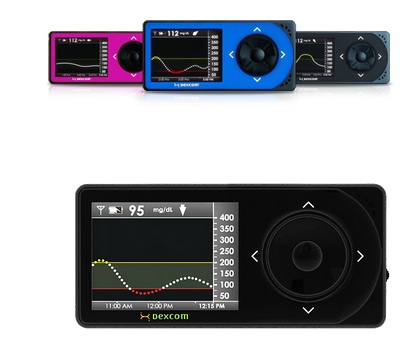 The Dexcom G4 was the continuous glucose monitor used in the study.
The Dexcom G4 was the continuous glucose monitor used in the study.
An artificial pancreas system -- consisting of a continuous glucose monitor, and insulin pump, and an iPhone 4s -- has been shown to improve glucose regulation in a simulated outpatient setting in both adults and adolescents with Type 1 diabetes, according to a new paper in the New England Journal of Medicine. The adult patients had their glucose in an acceptable range (between 70 and 180 mg per deciliter) 79 percent of the time when using the system, compared to 58 percent during the control period. For the adolescents the change was smaller but still improved -- 76 percent versus 65 percent.
In both studies, conducted by researchers from Boston University and Massachusetts General Hospital, patients were equipped with a Dexcom G4 continuous glucose monitor (CGM) and a t:slim infusion pump from Tandem Diabetes Care. The two devices were modified to work with a control algorithm running on an iPhone 4s in the patient's possession.
Patients calibrated the CGM twice a day with fingerstick glucometers, and logged meals qualitatively in the iPhone app. The algorithm used the meal information and the information from the Dexcom device to calculate and automatically administer doses of both insulin and the hormone glucagon, which insulin pumps don't normally dispense.
One major goal of the study was to test out an artificial pancreas in an out-patient setting, because previous attempts to develop such a system have often been in-patient, and one of the big advantages of using an iPhone as the control mechanism is the mobility it provides. Both trials lasted five days.
In the adult study, the 20 participants lived in a hotel in Boston but were free to eat what they wanted, move around at will (with a researcher shadowing them), and make use of the hotel's gym. In the adolescent study, the 32 teenagers were participants in a summer camp for kids with diabetes. Researchers theorized that the close supervision inherent in such an environment might account for the smaller difference between experiment and control groups among the teen group.
Between the two groups, the total number of carbohydrate interventions -- patients needing to eat quickly to raise their blood glucose -- was reduced by more than 50 percent.
The results of a similar trial were published in the Journal of Diabetes Care last August, but the outcome measure in that study was just the functionality of an iPhone-based system, rather than an actual effect on blood glucose or insulin levels.
The technology still has a long way to go. In the NEJM study, for instance, wireless connectivity problems between the devices caused a few missed doses. In addition, study author Dr. Steven J. Russel told the New York Times that the next step is to do a true outpatient study, where patients don't have constant supervision from doctors, researchers, or camp counselors.
“We need to do a true home-use study, give people the device and send them home,” he said. “Let them do whatever it is they’re going to do without supervision.”














